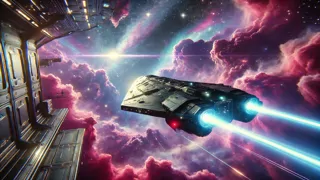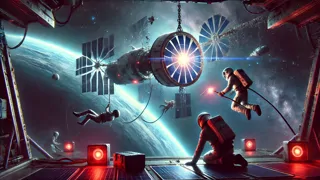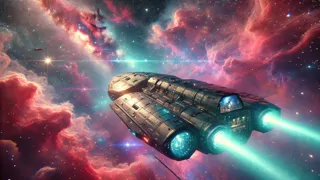Introduction
Under a tangerine sky that heralded the dawn of a new era, the Starbound Explorer stood poised on Launch Pad Echo, its gleaming hull reflecting the first blush of sunlight and the distant shimmer of the Milky Way. Years of meticulous engineering, late-night simulations, and sacrifices by countless teams had converged on this singular moment, and now Captain Elena Reyes and her crew—engineer Malik Arora, biologist Dr. Sofia Alvarez, and pilot Jiro Tanaka—prepared to step beyond Earth’s cradle. The air trembled with the low hum of auxiliary thrusters, and mission control’s voices crackled through the comms, a steady heartbeat guiding each check and countdown. In the command module, polished surfaces gleamed like precious metals as the crew settled into their pressure suits, hearts thrumming with anticipation. Outside, the world watched in hushed awe, screens flickering from coast to coast as the planet collectively held its breath. When the final tally reached zero, the engines roared to life in a crescendo of fire and light, lifting the Explorer toward the heavens. As Earth fell away beneath them, the curve of the planet framed by thinning atmosphere and the blackness of space, every soul aboard felt the weight of human longing and the uncharted promise that lay ahead. This was the moment where hope and uncertainty entwined, and the choices made in the silent vacuum would echo across the cosmos long after the vessel’s glow disappeared into the star-studded night.
Launch and the Unknown
As the Explorer slid beyond the protective cocoon of Earth’s magnetic field, the crew felt a collective shiver of awe and trepidation. Captain Reyes monitored the console as they crossed the asteroid belt, talc-white fragments and jagged remnants of primordial worlds drifting silently against the black canvas of space. Sensors hummed, scanning for micrometeoroids that could rend the hull in an instant, and every flicker on the viewscreen reminded them that even the smallest fragment carried immense force. Engineer Malik Arora adjusted the ship’s shields, fine-tuning energy allocations to reinforce vulnerable sectors, while pilot Jiro Tanaka calculated a delicate course through the densest clusters. Dr. Alvarez hovered beside a panoramic window, her breath fogging the glass as she studied the swirling dust-storm patterns illuminated by distant suns. Each heartbeat echoed the same question: what wonders lay waiting in the void, and how many challenges would stand between humanity and its next great leap?

Beyond the belt, the Explorer entered uncharted territory where electromagnetic pulses danced like silent specters across the sensors, and gravity anomalies twisted the ship’s trajectory unexpectedly. Communications with Earth grew faint as light-minutes stretched into hours, severing the comforting link to home in favor of isolation and self-reliance. The artificial gravity system hummed steadily, yet in the Empty Quadrant that hum seemed to mask the emptiness of countless light-years. In the science bay, Dr. Alvarez calibrated the spectrometer to analyze the chemical signatures of stellar winds—whispers from distant suns that held the secrets of planet formation. Meanwhile, Captain Reyes and Malik discussed mission parameters in hushed tones, aware that every discovery might conceal hidden dangers.
A faint nebula appeared on the horizon of the sensors, a swirling tapestry of ochre and silver gases dancing between stars. The Explorer edged closer, sensors racing to capture its spectral fingerprint while the crew braced for first contact with the cosmic mirage. Would they uncover new elements to fuel humanity's future, or unleash volatile reactions beyond control? In that silent vessel, memories of training drills failed to recreate the cold thrill of actual space—the way inertia turned fingertips into weighty anchors and time stretched around each trembling moment.
Long hours passed under dimmed lights as star fields slid past the observation port. The crew cataloged every particle, every quantum fluctuation that hinted at cosmic history. Jiro spent cycles piloting small micro-thruster adjustments to stabilize the trajectory, and Malik ran diagnostics on every system, ensuring that the Explorer remained a fortress against the void. In the galley, a faint aroma of synthesized coffee drifted through the corridors, a fragile reminder of life down home.
With the nebula's edge now behind them, a lone planet materialized—a sphere of swirling teal clouds and jagged coastlines reflecting a distant sun. Sensors detected unusual magnetic storms that sparked cobalt arcs across the atmosphere. The crew exchanged nervous glances: their first rendezvous with an unknown world lay just beyond the next burn.
Trials Among the Stars
Touchdown protocols initiated as the Explorer pierced the cobalt storms, its heat shields glowing with iridescent hues. The hull quaked under the pressure of magnetic turbulence, and alarms lit the command deck as the ship fought for control. Captain Reyes held the stick steady, her jaw tight with focus while Malik rerouted power from nonessential systems to reinforce thrusters and stabilizers. Outside, the planet’s surface revealed vast plateaus of crystalline rock that shimmered like broken mirrors in the stormlight, and patches of swirling vapor that hinted at underground oceans.

Once the tempest subsided, the crew prepared for their first extravehicular activity. In zero-gravity, they tasted the cold vacuum on their gloved fingertips as they tethered themselves to the airlock. Dr. Alvarez marveled at the bioluminescent flora that grew like coral on the rocky outcrops, soft azure tendrils waving in the faint wind. Each specimen they gathered promised clues to life’s adaptability, and every sample felt like a treasure from a world no human had ever touched. Jiro documented the landing site with high-resolution scans, ensuring no minute detail slipped through their scientific net.
Back on board, systems flickered unexpectedly. A rogue solar flare charged through the planet’s magnetic shield, inundating the Explorer with a surge that knocked sensors offline and threatened life-support reserves. Malik raced to divert emergency power, hands moving in practiced precision as the cabin lights dimmed and the hum of machinery stuttered. For a breathless moment, the ship lurched, and the crew held on to railings, hearts pounding in unison. Then, with a shudder and a crescendo of mechanical whines, systems rebooted and lights returned to their steady glow.
In the aftermath, the crew gathered around a holographic display, mapping storm paths and recalibrating shields. Discussions ran late into the vessel’s artificial night cycle as they weighed the risks of further planetary study against the possibility of deeper discoveries. Every new data packet seemed to point toward a complex biosphere—and every additional breadth of information meant an added strain on dwindling supplies. Yet their resolve remained unbroken: they would endure, adapt, and press on, driven by the shared belief that the universe held answers only they could obtain.
Choices and Consequences
Deep in the ship’s core, data streams converged on a single enigma: a faint distress signal pinging from a distant moon orbiting an uncharted gas giant. Its repetitive pulse suggested intelligence beyond natural phenomena—a call for help or a trap laid by unseen forces. The crew debated the path forward under the stark glow of the conference lamp, star charts and probability matrices floating in holo-space before them.

Captain Reyes argued for caution and a return to controlled analysis before engaging the signal’s source. Dr. Alvarez saw an opportunity to advance scientific knowledge beyond measure. Jiro weighed the moral imperative—could they ignore a potential plea for rescue, even if it jeopardized the mission? Malik ran simulations of both trajectories, each branching into dozens of potential outcomes. Minutes stretched into hours as the crew’s unity was tested by diverging convictions.
Finally, a consensus emerged: they would redirect course, but only after off-line backup of all research and a contingency plan to abort if danger proved overwhelming. The crew strapped in for the sudden burn, engines flaring hot as the Explorer pivoted into a new heading. Each member felt the shift in momentum not only in their bodies but in their collective spirit.
On approach to the moon, the distress beacon grew louder—an irregular sequence that hinted at a complex message encoded within. Hull sensors detected vast crystalline structures embedded in the rocky surface, refracting the gas giant’s ambient light into dancing spectrums. Whatever awaited them, the next steps would shape the legacy of their voyage. Whether they found allies in the darkness or unleashed forces beyond comprehension, every decision from this point onward would ripple through space and time, echoing long after their hull faded into the cosmic expanse.
Conclusion
Across the void, the Starbound Explorer carried the weight of every choice humanity had ever made, and the crew emerged forever changed by the brilliance and peril they had witnessed. They learned that perseverance was more than endurance; it was a willingness to confront the unknown with open hearts and sharpened wits. Some signals led to salvation, others to sacrifice, yet each discovery etched a new chapter in the story of humankind among the stars. When they finally broadcast their findings back to Earth—detailed archives of exotic elements, microbial life, and encrypted messages from distant moons—the world faced a renewed horizon of possibility. The mission’s legacy would not be a single triumph or tragedy, but the sum of every decision, every risk, every spark of human curiosity. In the end, Space and Beyond was not just a voyage across light-years, but a mirror held to our greatest strengths and vulnerabilities. Through perseverance and unity, the crew proved that even in the darkest reaches of space, hope can ignite the path forward.

















